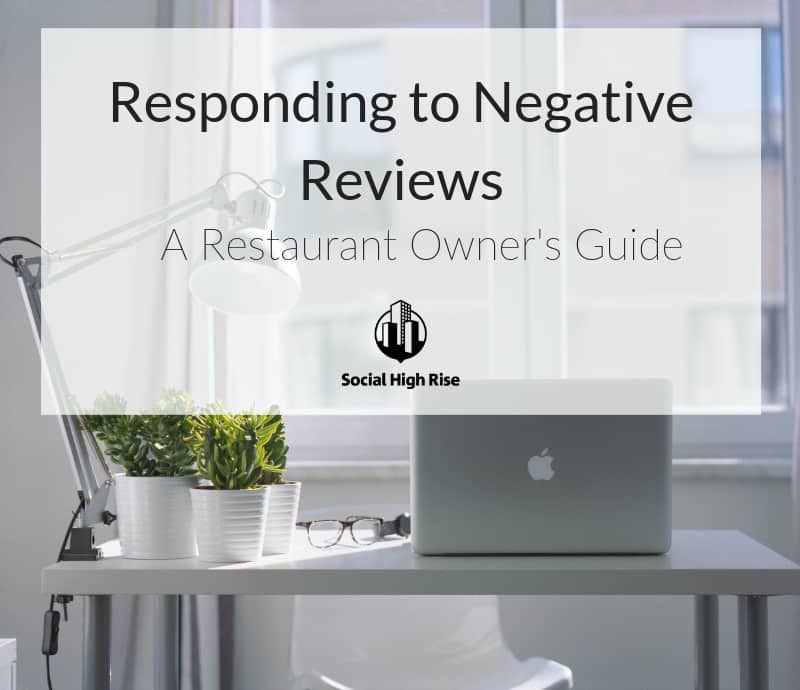I don’t think I’ve ever spoken to a restaurant owner who actually liked online reviews. Not surprising, given how anyone with a computer and internet access can go onto Yelp and drag a restaurant’s entire star rating down all because they had one mediocre experience one time and pretended like everything was just fine in the restaurant and didn’t say anything when they absolutely could have –
Sorry.
I’m bitter.
I admit to never having been a restaurant owner, but I worked in the food-service industry for almost a decade and am now working for an online reputation company. So just know I’ve seen some doozies.
- 1-star because their car got broken into while they were eating
- 1-star because a fellow customer cut them in line
- 1-star because they didn’t like the uniforms
So just know that I get it. I do.
But just like paying the bills or firing incompetent workers; responding to negative reviews is an ugly but necessary part of running your business. Take a deep breath though, I’m here to help you respond to those negative reviews like the pro-restaurateur you are!
Let’s get into it.
Step 1: Don’t Respond Right Away
You ever hear that tip to count to 10 when you’re angry so you don’t say something you regret? Well, it’s the same for responding to negative reviews. Except instead of counting to ten you should count to something higher – Like 10,000 (I’m only slightly exaggerating). You bust your butt every day to ensure your restaurant is running as good as it can be; so reading a negative review about your restaurant can be like watching your kid getting bullied on a playground.
So when it comes to negative reviews – do not respond right away! I know your first instinct might be to defend your business and/or you feel the need to respond to reviews immediately but trust me. You need time to cool off before you reply and honestly, the reviewer might need time to cool off as well. Yelp recommends replying to negative reviews within 3 days; that’s plenty of time for you and the reviewer to get yourselves together. But even if you first come across the review 3 days after it’s posted, still take the time. It’s better to take another hour or two and respond professionally than respond immediately and let your anger get the better of you. Take a walk, drink some tea, spend time with your family. The review will still be there when you get back, but this time you will be better emotionally equipped to handle it.
Pro-tip: When you read the review, do so in a flat, emotionless voice. I’m guilty of assigning pompous inflections to negative reviews; it gets me nowhere and puts me in a bad mood. Read it like Siri or Alexa would.
Step 2: Shift Your Perspective
Think of a time you went to a restaurant and had a negative experience. What did you think the problem was? Did you say anything to a manager?
An important thing to remember when someone leaves a negative review is that they never see behind the curtain. They don’t know that you had 3 employees call in sick or had an oven break down. They don’t know that you and your managers are friendly and open to feedback. And while it’s certainly unfair of them to assume your staff are bumbling fools or you are a prideful grump; sometimes all they need is a few more pieces to the puzzle to truly understand and be far more sympathetic.
It is also worth noting that you may not know what all is going on in their life. Maybe they’re trying to quit smoking or their kid just got suspended from school. A little empathy goes a long way in human-to-human misunderstandings. Try and get in this mindset before you jump in to respond.
Step 3: Get to the Heart of The Issue
When people are mad, they tend to go off on a tangent and potentially mention little things on top of their main source of anger. That doesn’t mean all of these perceived offenses carry the same weight or even need to be addressed.
If a reviewer goes off for 2 paragraphs about their rude server and then ends with, “The decor was old and musty too,” you don’t need to worry about that last bit. The main issue was clearly the service, the rest of the comments were likely added in anger and really mean nothing.
Before responding, re-read the review a couple of times to really make sure you understand what their main source of disappointment was. Sometimes there are 2 or 3 points, but generally no more than that. The more you do this the better you get at sifting through the odds and ends to really single out the core of their bad experience.
Step 4: The Response
I’m going to share with you the basic response structure we use at Social High Rise. It’s super helpful in getting started (sometimes that’s the hardest part) before going back in and making sure it’s what you want. You know that Mark Twain quote, “Write drunk, edit sober”? It’s like that – though I would advise against replying to negative reviews drunk, as tempting as that might be! This response structure helps me and my colleagues to get a reply down quickly (writing “drunk”) before looking back through it to make any necessary changes (edit sober).
Response Structure:
- Intro
- Address Feedback
- Action/Education
- Farewell
Simple, but effective.
Intros are simple. Greet them, thank them for the feedback or let them know why you’re reaching out to them. “Hi Susan, thank you for taking the time to leave this candid feedback” or “We wanted to personally reach out to you after reading about your experience.”
Addressing feedback is taking the points they made in their review and clearly and concisely repeating it back to them. This not only shows that you’re paying attention, but helps set up the promise of action/education. “While we’re thrilled to hear you loved your server, we are sorry if our cuisine did not live up to our reputation.” Or, “We are known for our refreshing cocktails and excellent service and we are sorry if this is not what you received.”
The promise of action is probably the most complicated because it depends so heavily on the review. If their complaint was something minor that could have been easily fixed in-house, you can put the need of action in their hands. “Please know we will happily remake or replace anything you’re not satisfied with, simply let our friendly staff know.” If it is something more troubling that appears to be the fault of the staff, promise the reviewer that their comments will be addressed. “I assure you, this is not in line with the expectations I have set for my staff and I will be looking into this myself.” This can be paired with, “Could you please tell me the exact date/time of your visit so I know whom to address?” Sometimes all people want is to know their experiences are valid and being acknowledged.
Education is for special circumstances or procedures that customers were most-likely unaware of, such as an oven breaking down or a unique law your restaurant must follow. It’s totally possible to explain this without sounding like you’re trying to make excuses. And, as I stated above, customers can be very empathetic and understanding if given the chance. “Our old oven gave out last night and I’m afraid it completely threw us off-course.” or “By Utah state law, we are not allowed to serve beers stronger than 4% ABV after midnight, though I will follow up with my team to ensure they are communicating this in a clear and friendly way.” (P.S. – This is a real law in Utah and this is why I do not live in Utah).
Farewells are not simply for goodbyes, you can invite them back or reaffirm your promise of action. “Should you be willing to give us another chance, we would love the opportunity to win you over in the future!” or “Thank you again for sharing your experience and for bringing this incident to my attention. We wish you all the best.” In the event of an extremely difficult reviewer who you know would not come back (or that you don’t want back), you can always go for the professional, “I appreciate you taking the time to read my response. Take care.”
Getting the basic response out can be the hardest part but just getting something down can make all the difference. Once you’ve done that, go back in and make any necessary modifications to make the response more unique. Easy peasy.
Step 5: Reflect on Feedback
Taking feedback is difficult for anyone in any position, but acknowledging weaknesses and dealing with them is the best way to grow. While you may want to brush off any and all negative reviews as the reviewer simply being a jerk, the fact is that most negative reviews (even the rude ones) do have some legitimacy in their complaints. This is especially important because most people do not leave reviews at all, they will simply not come back. So for every one person to actually leave a negative review about a tough steak they had, there’s a decent chance there were several more who didn’t say anything in-person or online.
Or, maybe not. Maybe that tough steak the person was complaining about really was a one-off thing, but that’s why these negative reviews can be valuable. They point out something that is worthy of investigation.
Had a reviewer complain about overripe bananas in their crepe? Ask the kitchen manager to check on the bananas. A reviewer had a bad experience with a hostess on Friday night? Tell your head server to find out who was hosting that night and have a quick chat with them on friendliness. I’m not saying to you have to drop everything and address it then and there, but jot it down so you can address it in your next meeting or delegate it out as you can.
Another thing to note is to keep tabs on repeat complaints. If 3 different people on 3 different occasions complain about soggy salad, it might be time to reconsider how you wash and store your lettuce. If you keep getting complaints about a rude manager, it may be time to rethink who’s on your team.
Flagging:
Something not enough restaurant owners take advantage of is the flagging option. All sites with reviews have the option to flag a review, though, some sites are better at taking them down than others. In our experience, Yelp and TripAdvisor are pretty good at actually considering flag petitions and removing reviews. Facebook and Google Business are absolutely terrible at removing reviews and I would not hold your breath.
Yelp and TripAdvisor each have guidelines that they ask their reviewers to follow and it’s actually not super rare for reviewers to violate those guidelines. For example, Yelp requires a person to write about their own experience and not anybody else’s. I know that seems obvious, but I’ve come across a decent amount of “My wife and her sister went here last night and…” or “I saw in another review that some guy had…” in my day. You bet they were flagged and removed!
However, Yelp and TripAdvisor do not get involved in factual disputes. If it’s a “their word against mine” type situation your flag will most likely be rejected. The best process for those types of factual disputes or miscommunications is to just respond.
I heartily advise familiarizing yourself with Yelp and TripAdvisor’s guidelines and don’t be afraid to give flagging a try. The worst thing that can happen is they reject your flag petition. Two things to note here, however.
- You can submit a second flag in another attempt to get the review removed. This puts more scrutiny on the review and has been successful for us in the past. But, two shots is all you get so be sure to construct your argument carefully!
- Don’t go crazy on flagging. I know it’s tempting to try and get every negative review removed but you are not going to do yourself or your business any favors. Yelp/TripAdvisor will get to know you as the constant flagger and any genuine flag attempts won’t be taken as seriously. Also, if you’re getting consistent negative reviews, that’s a good sign something isn’t working in your business. Redirect the energy you would use to flag reviews into improving your restaurant.
To recap:
- Don’t respond right away
- Put yourself in the customer’s shoes
- Get to the heart of the issue
- Write drunk, edit sober
- Flagging is an option, but one that should be used sparingly
And hey, if you’re still feeling overwhelmed by the idea of responding to reviews, the crew Social High Rise is here to help!
Recommended Reading: “Hug Your Haters” by Jay Baer.
Did you know?
We've been managing social media accounts for restaurants since 2012. For almost a decade, we've partnered with restauranteurs who are serious about using social media to generate business. Whether you're a good fit for our service or not, let's schedule a call and we'll give you free personalized advice on how to improve your social media presence. Either way, you'll walk away from the call more confident about your ability to promote yourself online - completely for free.







